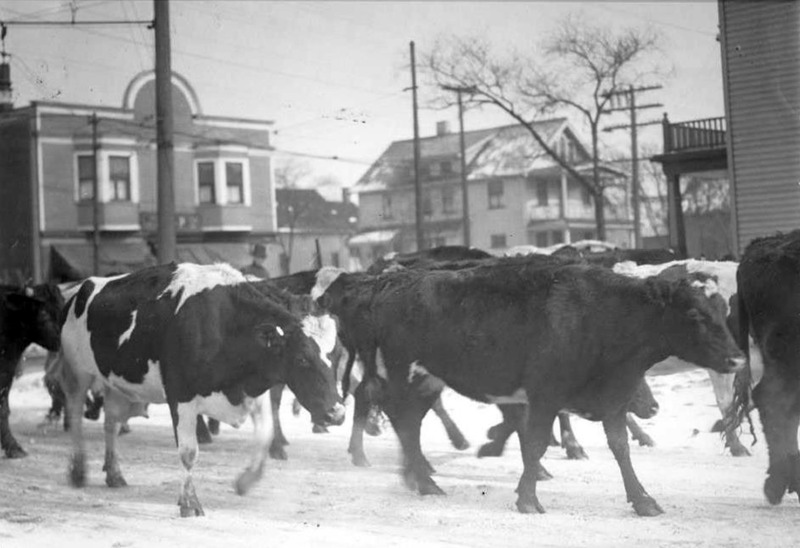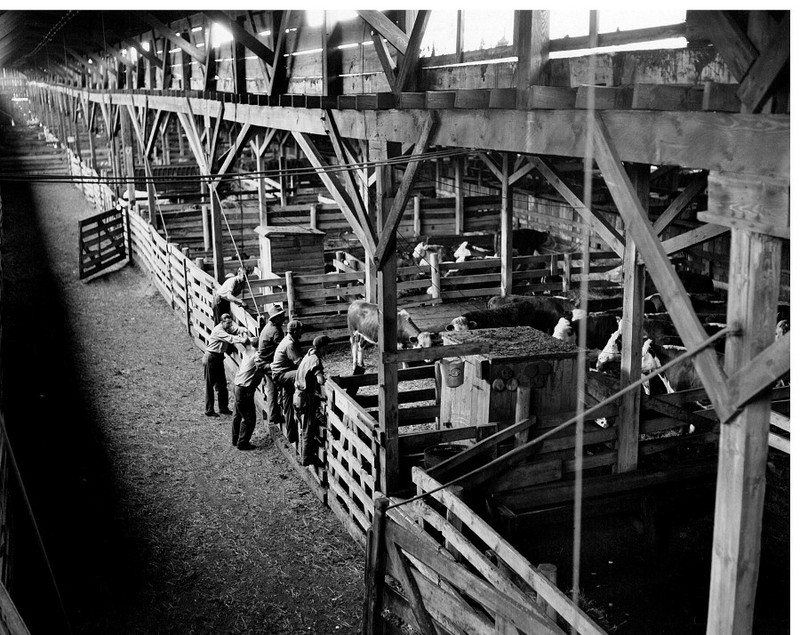
You're driving south on West 65th Street in your Ford Model T, sometimes called a Tin Lizzie. You pass St. Colman Roman Catholic Church on your left, then the Cleveland Trust bank building on the corner of Lorain Avenue, and just a little later Gordon Elementary School on your right. You're behind a trolley on this cold Monday morning, January 24, 1927. Traffic is moving even slower than usual. You wonder what the holdup is ahead.
Then you hear it . . . the sound of hard hooves on red brick street. You don't see them at first. But as you get closer to Clark Avenue and the Big Four Railroad tracks, you catch a glimpse of the herd-- brown, black and white splotches of color, a dozen or so head of cattle, coming your way, weaving through traffic. The steers pay no attention to the rules of the road. Some are trying to make it to the middle of the street, others want to turn back, but the drovers with their long sticks are there to guide them, keeping them close to the curb. As you proceed past the intersection, you reach the herd, taking in the smell now as well, and you carefully pass by.
The herd is on its way to the slaughterhouse of the Long Dressed Beef packinghouse on West 68th Street, where the individual cattle will become steaks, roasts and other beef products for Cleveland's meat-hungry population. But after you have passed them and the flow of traffic on West 65th has improved a little, you and your traveling companions don't give the cattle or the fate that awaits them any further thought.
For the first two-thirds of the twentieth century, it wasn't unusual for motorists like these to encounter herds of cattle, flocks of sheep, or a drove of hogs, all on their way from the Cleveland Union Stockyards to nearby slaughterhouses-- sometimes more elegantly referred to as "abbatoirs." On a daily basis, buyers from Swift & Company, Ohio Provision, Theurer-Norton, Webb Beef, Gibbs, Inc., and the other meat packers and renderers whose buildings stretched around the Stockyards like a giant inverted "C," would come to the yards. There they dickered with commission agents of the farmers who had raised the cattle, sheep and hogs in Ohio, Michigan and elsewhere and had then transported them by rail to Cleveland's Union Stockyards for sale. Buyer and seller squabbled over quantity and price per pound. And, when a buyer was finally sure that he hadn't been given a "bum steer," a deal would be struck. All that remained then was to transport the animals purchased to the meat packer's slaughterhouses. Given their geographical proximity to the Stockyards, the easiest way to accomplish that was to simply walk the animals there.
And so west side motorists, like those traveling south on West 65th Street on January 24, 1927, had to deal with these walking cattle, sheep, and pigs that slowed down traffic. But their inconvenience was minor compared to what people who lived in the Stockyards district had to endure. Residents of the Isle of Cuba, the Czech immigrant neighborhood located just east of the stockyards and packinghouses, dealt daily and constantly with raucous animal noise and horrific stench. Moreover, every so often animals would escape, and residents would come home to find cattle, hogs or sheep munching their lawns, trampling their gardens, breaking fence posts, and sometimes even endangering their children.
The meat packers and renderers of the Stockyards District, as well as the stockyards themselves, certainly did create neighborhood nuisance. But as Cleveland's third largest industry, they also employed thousands of Clevelanders. It all ended--jobs as well as nuisance, in the late 1950s through early 1970s, when first the packinghouses abandoned Cleveland as a regional meatpacking center and then the Stockyards closed.
Today, the ruins of the old packinghouses still stretch along the east side of West 65th Street between Clark and Storer Avenues, but now you have to look at an historic photo or talk to a long-time resident of the Stockyards neighborhood to understand a little bit of what it was once like to see cattle ambling their way down the streets of Cleveland's west side.
Images








